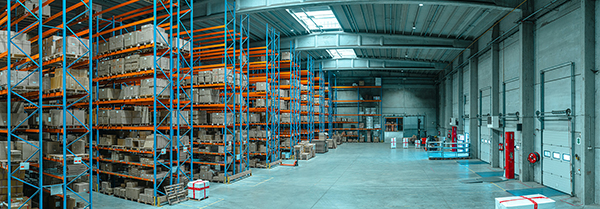Process Orchestration helps the supply chain industry rapidly identify, vet and automate business and IT processes to operate efficiently.

No industry is feeling the pressure quite like the supply chain. Between economic uncertainty and ongoing shortages – from automotive microchips to baby formula – the strain on supply chains has lingered into 2022 and will remain for the foreseeable future. According to industry analysts at Gartner, 34% of supply chain organizations said that adapting to new technology is the most important strategic change they will face five years from now. In the same report, Gartner also named “hyperautomation” as one of the top supply chain technology themes of 2022.
But what is hyperautomation, and how can you make it work for your company? Gartner defines hyperautomation as “a business-driven, disciplined approach that organizations use to rapidly identify, vet and automate as many business and IT processes as possible.” Hyperautomation involves the orchestrated use of multiple technologies, tools or platforms, such as artificial intelligence, event-driven software architecture, robotic process automation (RPA) and more.
The operative word in that definition is “orchestrated.” To get hyperautomation right, supply chain organizations must think about the holistic picture. In other words, how do you orchestrate processes across all of your people, systems and devices? How will your process automation efforts make your warehousing, transportation, production and other aspects of your business operate more efficiently?
Let’s dive into how.
One of the biggest challenges associated with hyperautomation is knowing where to start. Organizations may have hundreds or even thousands of processes to automate and orchestrate across their people, systems, and devices. The best way to break down this challenge is to focus on a pilot project that serves as a proof of concept (PoC) for both business and IT stakeholders.
A prototype application is created for a specific automation, and showcased within the span of just days to a few weeks. The results detail whether or not an automation project will work for your specific scenario. Typically two to four people are enough to test a PoC. These team members should have the skills to use process modeling frameworks like Business Process Model and Notation (BPMN) to execute a project technically in your environment.
BPMN helps you diagram key business processes, and present the results in an easy-to-read flowchart format for both business and technical stakeholders.
Key questions to ask at the start of a PoC might include:
After the PoC is completed and these questions can be answered, the pilot PoC team will play a much larger role in planning the order of automation projects, executing them, and measuring their success. While it might seem tempting to try to force an organization-wide system all at once, a PoC approach is a safer bet to ensure the long-term success of your process automation and orchestration initiatives.
Many supply chain organizations have legacy technology that’s standing in the way of their hyperautomation goals. In the past, the best move was to rip out this legacy tech and replace it with something else. However, most companies can’t afford more disruptions or multi-million dollar, multi-year projects.
Fortunately, process automation and orchestration can play a critical role in gradual digital transformation. For example, some organizations may be using RPA bots to automate order fulfillment processes. That’s step one in the gradual transformation. Step two may be to orchestrate multiple bots together with IT systems or supervisor approvals. Step three might be to sunset an RPA bot and replace it with a modern, microservices-based application. Modern applications tend to be more robust, and can be easily plugged into existing end-to-end processes.
Using this approach, a supply chain organization can start with the most urgent processes first. Automating one project at a time allows for experimentation and learning. That way, your team can work with older technology, take advantage of new technology, and tie the two together with your existing people and processes.
Breaking a larger process automation project into smaller, more manageable pieces is not the same as automating in silos. Many organizations make the mistake of adopting their own departmental automation technologies, and don’t communicate their results with the rest of the organization. There’s no pilot project, or team managing the rollout. As a result, it can be difficult to understand how processes are operating from end-to-end, let alone how to improve them.
For example, an organization might need to orchestrate legacy systems, microservices, RPA bots, APIs, AI/ML tools, IoT devices, human tasks and more. Viewing each of these processes in a silo would miss out on the ability to make multiple endpoints work together seamlessly across the organization.
Using the gradual modernization approach described above, you can orchestrate these systems component by component, until the time and resources can be dedicated to rewriting legacy applications. Hyperautomation need not be disruptive to operations or the customer experience. However, process orchestration plays a critical role in ensuring that each new proces plays into a greater whole. As most supply chain organizations know, even one missing link can cause incredible disruption. The same holds true for how you should think about hyperautomation to ensure long-term success.

About the Author:
Jakob Freund is co-founder and CEO of Camunda – responsible for the company’s vision and strategy. He’s also the driving force behind Camunda’s global growth and takes responsibility for the company culture. As well as holding an MSc in Computer Science, he co-authored the book “Real-Life BPMN” and is a sought-after speaker at technology and industry events.
In this episode, I sat down with Beejan Giga, Director | Partner and Caleb Emerson, Senior Results Manager at Carpedia International. We discussed the insights behind their recent Industry Today article, “Thinking Three Moves Ahead” and together we explored how manufacturers can plan more strategically, align with their suppliers, and build the operational discipline needed to support intentional, sustainable growth. It was a conversation packed with practical perspectives on navigating a fast-changing industry landscape.